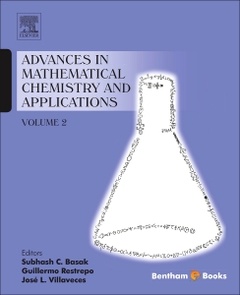Advances in Mathematical Chemistry and Applications: Volume 2
Coordonnateurs : Basak Subhash C., Restrepo Guillermo, Villaveces Jose L.

Advances in Mathematical Chemistry and Applications highlights the recent progress in the emerging discipline of discrete mathematical chemistry. Editors Subhash C. Basak, Guillermo Restrepo, and Jose Luis Villaveces have brought together 27 chapters written by 68 internationally renowned experts in these two volumes.
Each volume comprises a wise integration of mathematical and chemical concepts and covers numerous applications in the field of drug discovery, bioinformatics, chemoinformatics, computational biology, mathematical proteomics, and ecotoxicology.
Volume 2 explores deeper the topics introduced in Volume 1, with numerous additional topics such as topological approaches for classifying fullerene isomers; chemical reaction networks; discrimination of small molecules using topological molecular descriptors; GRANCH methods for the mathematical characterization of DNA, RNA and protein sequences; linear regression methods and Bayesian techniques; in silico toxicity prediction methods; drug design; integration of bioinformatics and systems biology, molecular docking, and molecular dynamics; metalloenzyme models; protein folding models; molecular periodicity; generalized topologies and their applications; and many more.
2. Similarity in Chemical Reaction Networks: Categories, Concepts and Closures, Andres Bernal, Eugenio Llanos, Wilmer Leal and Guillermo Restrepo
3. Discrimination of Small Molecules Using Topological Molecular Descriptors, Chandan Raychaudhury and Debnath Pal
4. The Periodicity of Molecules, Fanao Kong, Weiqiang Wu, Na Ji and C. L. Calson
5. The GRANCH Techniques for Analysis of DNA, RNA and Protein Sequences, Ashesh Nandy
6. Linear Regression, Model Averaging, and Bayesian Techniques for Predicting Chemical Activities from Structure, Jarad B. Niemi and Gerald J. Niemi
7. Marine Algal Toxicity Models with Dunaliella tertiolecta: In Vivo and In Silico, Melek T. Saçan, Marjana Novic, M. Doga Erturk and Nikola Minovski
8. Anti-Tubercular Drug Designing Using Structural Descriptors, Manish C. Bagchi and Payel Ghosh
9. Integrating Bioinformatics and Systems Biology for Exploring Novel Lipid Pathways in Infectious Diseases, Sonali Shinde, Vineetha Mandlik and Shailza Singh
10. Applications of Molecular Docking and Molecular Dynamics on the Inhibition of Quorum Sensing Systems, Santiago Medina, Susana Casas, Mariana Restrepo, Alejandro Alvarez, Adriana J. Bernal and Andres Fernando Gonzalez Barrios
11. Designing Models for Metalloenzymes, James F. Weston
12. The Multi-Factor Coupled Protein Folding: Insights from Molecular Dynamics Simulations, Xiaomin Wu, Gang Yang and Lijun Zhou
13. Generalized Topologies: Hypergraphs, Chemical Reactions, and Biological Evolution, Christoph Flamm, Barbel M. R. Stadler and Peter F. Stadler
MSc and PhD students, academic personnel and researchers seeking updated and critically important information on the fundamental concepts of mathematical chemistry and their applications; scientists working in new drug discovery and hazard assessment of chemicals
There are two main interests in the research carried out by Professor Guillermo Restrepo: mathematical chemistry and philosophy of chemistry. His mathematical approaches to chemistry have been through discrete mathematics, especially graph and order theory and point-set topology. This research has led him to estimate properties of substances, to assess environmental targets, and to find novel structures of chemical constructs such as the periodic system of chemical elements. His questions in philosophy of chemistry have to do with the mathematical way of thinking and its realization in chemistry. Professor Restrepo is Fellow of the Alexander von Humboldt Foundation/Stiftung, member of the International Academy of Mathematical Chemistry, and of the Executive Committee of the International Society for the Philosophy of Chemistry. He is also a member of the editorial board of MATCH Communications in Mathematical and in Computer Chemistry, and of Hyle -- International Journal for Philosophy of Chemistry.
Theoretical chemistry, history, and philosophy of chemistry are some of the scientific interests of Professor José L. Villaveces. His approaches to theoretical chemistry range from quantum chemistry to mathematical chemistry, where topology plays a central rol
- Brings together both the theoretical and practical aspects of the fundamental concepts of mathematical chemistry
- Covers applications in diverse areas of physics, chemistry, drug discovery, predictive toxicology, systems biology, chemoinformatics, and bioinformatics
- About half of the book focuses primarily on current work, new applications, and emerging approaches for the mathematical characterization of essential aspects of molecular structure, while the other half describes applications of structural approach to new drug discovery, virtual screening, protein folding, predictive toxicology, DNA structure, and systems biology
Date de parution : 01-2016
Ouvrage de 354 p.
19x23.4 cm
Thèmes d’Advances in Mathematical Chemistry and Applications... :
Mots-clés :
Fullerene Stability; Chemical Reaction Networks; Small Molecules; Molecular Topology; Molecular Periodicity; GRANCH Techniques; Linear Regression; Model Averaging; Bayesian Techniques; Marine Algal Toxicity; Structural Descriptors; Bioinformatics; Systems Biology; Molecular Docking; Molecular Dynamics; Metalloenzymes; Protein Folding; Hypergraphs



